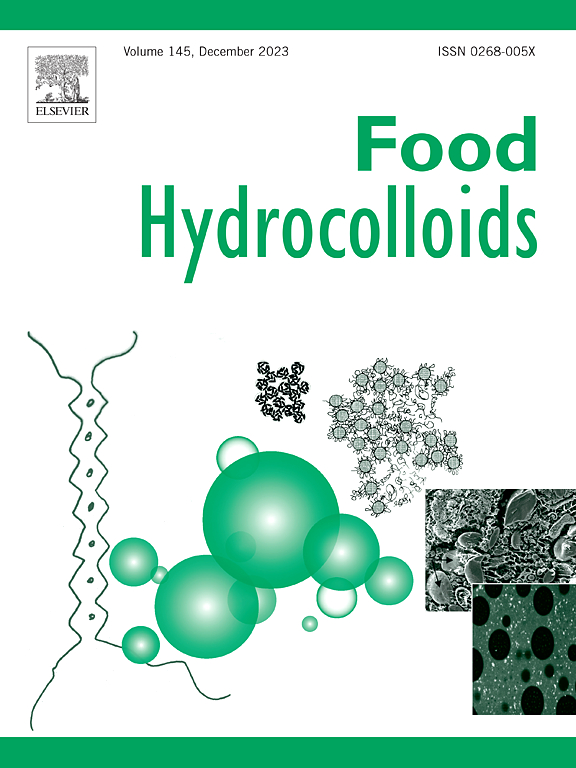α-淀粉酶介导的具有不同凝胶性质的马铃薯变性淀粉的制备
IF 11
1区 农林科学
Q1 CHEMISTRY, APPLIED
引用次数: 0
摘要
本研究考察了从不同糖苷水解酶13 (GH13)亚家族(GH13_1、GH13_5、GH13_37和GH13_42)中选择的7种微生物α-淀粉酶对马铃薯淀粉凝胶性和凝胶性的影响。结果显示出不同的降解谱,反映了对直链淀粉和支链淀粉的不同偏好。淀粉凝胶的流变学分析表明,未经培养的海洋细菌的GH13_37 α-淀粉酶Um-α -amy处理的淀粉具有优异的凝胶性能,而催化效率高的芽孢杆菌源的GH13_5 α-淀粉酶处理的淀粉胶凝能力特别差。结果表明,Um-α - amy处理后的淀粉具有较强的凝胶特性,可能与优先的、可控的直链淀粉降解以及有限的支链淀粉活性有关。对酶结构模型的评估表明,活性位点构象与淀粉降解谱之间可能存在相关性,开放的构象可能增强支链淀粉的降解能力,因此,所得淀粉的凝胶化能力较差。此外,Um-αAmy有限的热稳定性被证明是一个理想的特性,有助于更可控的酶促淀粉改性过程。总之,这些发现为α-淀粉酶系统发育和分类在受控酶促淀粉改性中的重要性提供了新的见解,并突出了α-淀粉酶在酶促生产具有不同凝胶性质的改性马铃薯淀粉方面的潜力。本文章由计算机程序翻译,如有差异,请以英文原文为准。

α-Amylase mediated production of modified potato starch with distinct gel properties
This study examines how seven microbial α-amylases selected from different glycoside hydrolase 13 (GH13) subfamilies (GH13_1, GH13_5, GH13_37, and GH13_42) affect the molecular and physical properties of potato starch with respect to gelation and gel properties. The results revealed distinct degradation profiles, reflecting different preferences for amylose and amylopectin. Rheological analysis of the starch gels revealed that, notably, starch treated with Um-αAmy, a GH13_37 α-amylase from an uncultured marine bacterium, had superior gel properties, while starch treated with catalytically efficient Bacillus-derived α-amylases of GH13_5 exhibited particularly poor gelling abilities. The results suggest that the strong gel properties of Um-αAmy treated starch are likely associated with a preferential, yet controlled, amylose degradation combined with a limited activity on amylopectin. Assessment of the enzyme structure models indicated a possible correlation between active site conformation and starch degradation profiles, with open conformations potentially enabling enhanced amylopectin degrading ability, and thus, poor gelling ability of the resulting starch. Furthermore, the limited thermal stability of Um-αAmy turned out to be a desirable trait, facilitating a more controlled enzymatic starch modification process. Altogether, these findings provide a novel insights into the significance of α-amylase phylogeny and classification in controlled enzymatic starch modification and highlight the potential of selected α-amylases for enzymatic production of modified potato starch with distinct gel properties.
求助全文
通过发布文献求助,成功后即可免费获取论文全文。
去求助
来源期刊

Food Hydrocolloids
工程技术-食品科技
CiteScore
19.90
自引率
14.00%
发文量
871
审稿时长
37 days
期刊介绍:
Food Hydrocolloids publishes original and innovative research focused on the characterization, functional properties, and applications of hydrocolloid materials used in food products. These hydrocolloids, defined as polysaccharides and proteins of commercial importance, are added to control aspects such as texture, stability, rheology, and sensory properties. The research's primary emphasis should be on the hydrocolloids themselves, with thorough descriptions of their source, nature, and physicochemical characteristics. Manuscripts are expected to clearly outline specific aims and objectives, include a fundamental discussion of research findings at the molecular level, and address the significance of the results. Studies on hydrocolloids in complex formulations should concentrate on their overall properties and mechanisms of action, while simple formulation development studies may not be considered for publication.
The main areas of interest are:
-Chemical and physicochemical characterisation
Thermal properties including glass transitions and conformational changes-
Rheological properties including viscosity, viscoelastic properties and gelation behaviour-
The influence on organoleptic properties-
Interfacial properties including stabilisation of dispersions, emulsions and foams-
Film forming properties with application to edible films and active packaging-
Encapsulation and controlled release of active compounds-
The influence on health including their role as dietary fibre-
Manipulation of hydrocolloid structure and functionality through chemical, biochemical and physical processes-
New hydrocolloids and hydrocolloid sources of commercial potential.
The Journal also publishes Review articles that provide an overview of the latest developments in topics of specific interest to researchers in this field of activity.
 求助内容:
求助内容: 应助结果提醒方式:
应助结果提醒方式:


